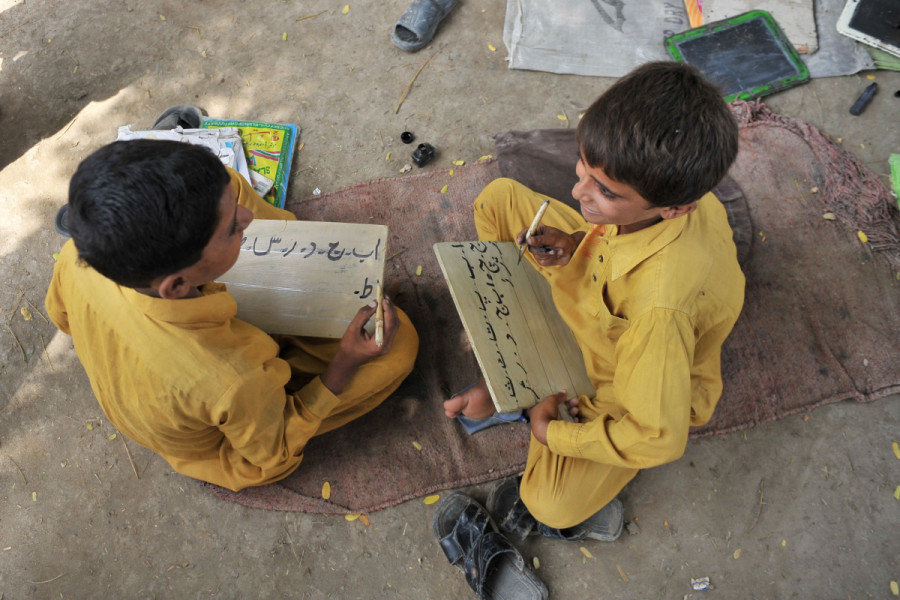Columns
Saving the future of young Pakistanis
Pakistanis need emergency help to prevent a further loss of learning among children.
Yasmine Sherif & Gordon Brown
Following this year’s catastrophic flooding in Pakistan, millions of young Pakistanis’ life opportunities are hanging by a thread. The floods caused more than $10 billion worth of damage, and emergency support is urgently needed to rebuild. The crisis will be top of mind as United Nations Secretary-General António Guterres and 120 national leaders gather later this month in New York for the Transforming Education Summit.
The roughly 16 million children who have been displaced by the floods are merely the latest of Pakistan’s young people to lose out on education, joining an already huge population of 22.8 million children who are out of school. Worse, as landslides follow the floods, the threat of famine is increasing. Around 45 percent of the country’s agricultural land has already been destroyed. The humanitarian situation is rapidly deteriorating to dangerous levels.
In recent years, we have visited many of the areas of Pakistan that are now underwater—where more than 1,100 people have now been killed, one million homes have washed away, and 33 million Pakistanis have been affected. With some provinces having had five times more rainfall than the 30-year average for this time of the year, 66 districts have been declared “calamity hit,” including 31 in Balochistan, 23 in Sindh, nine in Khyber Pakhtunkhwa, and three in Punjab. Four million acres of crops and 800,000 livestock have already been wiped out.
As with previous disasters in Pakistan—from the 2005 earthquake to the 2011 floods—the most immediate need is for food, tents, and tarpaulins. But as participants in the Transforming Education Summit will hear, Pakistan is far from the only country where a combination of climate change and conflicts are dramatically increasing the number of children at risk of missing out on an education. The Education Cannot Wait fund’s replenishment conference is not until February, which is too far off. Today’s humanitarian disasters are hitting children the hardest, demanding an immediate increase in emergency funding.
In Pakistan alone, at least 18,000 schools have been damaged or destroyed by the flooding, including 15,842 in Sindh, 544 in Balochistan, and 1,180 in Punjab. Several thousand more schools have become unsafe, and 5,500 have had to be requisitioned to accommodate people displaced from their homes.
Moreover, these figures are almost certainly an understatement of the scale of the damage that will need to be repaired. Continued rainfall and high water levels prevent proper appraisals, but one rapid-needs assessment of 10 districts of Balochistan found that 977 classrooms were completely destroyed and 975 damaged, while 577 schools could not be used because they had been converted to temporary shelters.
Pakistanis need emergency help to prevent a further loss of learning among children who already missed out on months of education during the Covid-19 pandemic. Such support would go to establish temporary learning centres (TLCs) and alternate learning modalities in flood-affected districts, where educators will need to rely on emergency teaching aids such as “school-in-a-box” sets, school tents, and other teaching and learning materials. After that, dewatering, cleaning, and disinfecting schools will require further funding, as will the provision of psychological and social support for some pupils following this summer’s traumas.
Fortunately, the response has already begun in some places. Around 30 TLCs for 3,600 children—including 1,100 girls—have been established in Pishin, and one TLC is now operating in Lasbela, Balochistan. Additional teaching materials will soon reach 35,000 children in Sindh and Punjab.
But this support costs money. That is why the UN Education Sector Working Group is requesting $10.2 million in additional funds to establish temporary learning spaces, distribute materials, and clean up schools. Moreover, in addition to the $2 million that Education Cannot Wait is now investing in Pakistan’s flood response, some of the funding that it has set aside for multiyear humanitarian-development programs will also be redirected to Pakistan.
Other crisis-hit countries, including Afghanistan, Ukraine, and Ethiopia, urgently need emergency assistance as well. With their needs in mind, two of the big requests at the Transforming Education Summit will be for countries facing emergencies to increase their education budgets, and for countries subject to International Monetary Fund programmes to be exempted from education budget cuts.
With tens of millions of children already trying to catch up after the pandemic, all international organisations should be doing everything they can to expand financial support for education. We must not let the talents and potential of this generation of young people go to waste as a result of our own neglect. No one should forget the promise enshrined in Sustainable Development Goal 4: “Ensure inclusive and equitable quality education and promote lifelong learning opportunities for all” by 2030. That goal can still be achieved; but only if we focus on the needs of crisis-affected, refugee, and displaced children and young people.
—Project Syndicate




 6.84°C Kathmandu
6.84°C Kathmandu
















